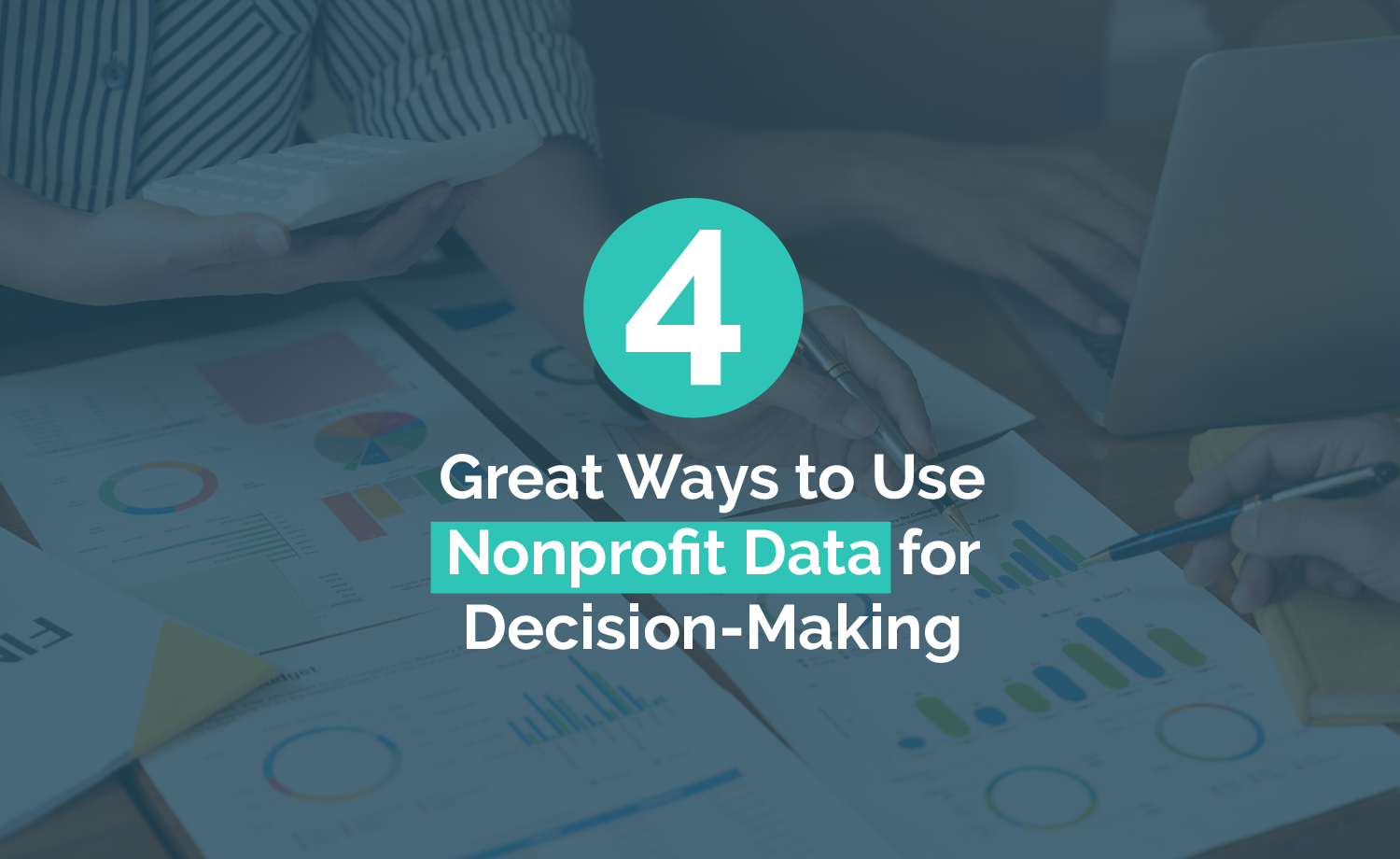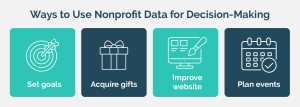
Whether your nonprofit’s goal is to grow a greener world or to make education accessible for all children in the community, you’re likely constantly looking for ways to improve your operations and better serve your beneficiaries. However, you might find it difficult to pinpoint exactly what part of your nonprofit needs changing.
That’s where data comes in! By collecting and assessing nonprofit data, you can confidently make informed decisions to enhance your organization’s impact.
In this guide, we’ll discuss four ways you can use nonprofit data for decision-making purposes. Let’s get started!
1. Set goals for your nonprofit.
The first, and perhaps most important way you can use data is to help set goals for your nonprofit. To create a goal and determine the path to achieve it, apply your nonprofit data to the SMART framework for goal-setting:
- Specific
- Measurable
- Achievable
- Relevant
- Time-bound
Let’s consider nonprofit revenue, for example. By tracking your annual revenue and overhead, you’ll have a clearer picture of what your nonprofit can achieve. If you raised $500,000 last year, you might set your goal for the current year as $550,000.
You can also use data to help inform your goal-setting by examining the success of your programs. Let’s say that your nonprofit was able to help 3,000 individuals in the local community through clothing drives last year. However, the year before that, you hosted a fundraising gala that raised enough funds to provide clothing to 4,000 individuals. In that case, you might pivot to hosting more fundraising events and seeking out other revenue sources, such as matching gifts.
2. Acquire more gifts through donor data.
Your nonprofit likely has revenue-related goals, and reasonably so! After all, you can’t help your beneficiaries without the proper funding. Donor data can reveal better strategies for acquiring more gifts for your cause.
A few types of donor data your nonprofit should collect include:
- Demographics. This includes age, gender, location, and occupation. With this information, you’ll have a better grasp of the type of people that give to your organization.
- Giving history. This includes gift amount, frequency, and preferred donation method. This information will help you pinpoint your donors’ giving habits and preferences.
- Engagement history. This includes event attendance and volunteer time. Aside from donations, this information is one of the best ways to gauge how connected your supporters are to your cause. And the more connected they are, the more likely they are to give.
With this information, you’ll be able to create data-driven marketing strategies to encourage donors to make more gifts to your organization. For example, let’s say that you discover that a majority of your donations come in through mobile devices. In that case, a text-to-give campaign might be very appealing to your supporters. According to Snowball, these campaigns are very convenient—all supporters need to do is text a keyword and donation amount to a phone number assigned to your nonprofit by its text-to-give provider.
By assessing donor data, you’ll be able to make the right decisions to create a more convenient gift process that simplifies donations. And, with strategies such as personalized communications and segmentation, you’ll be able to foster relationships with your supporters for years to come.
3. Improve your website.
Your website is an extremely useful marketing tool if you leverage it properly. From your donations form to your charity auction event page, each part of your website should work together seamlessly to create a positive user experience that engages visitors and encourages them to learn more about your organization.
To that end, you can use data to improve your website by tracking the following metrics:
- Traffic sources. Check where your visitors are accessing your site from, whether that’s through search engines, social media, or other websites. If you’re seeing many individuals coming to your site through search engines, for example, then you know that your search engine optimization strategies are probably working.
- Bounce rate. Bounce rate refers to the percentage of visitors who leave your site after viewing only one page. If your bounce rate is high, then you may want to reassess the user experience and navigation setup of your website.
- Conversion rates. Perhaps the most important metric is conversion rate, which refers to the number of visitors who complete your desired action, whether that’s signing up for your newsletter or making a donation. A low conversion rate can be the result of a variety of issues, but being aware of it is the first step to making necessary improvements.
By tracking these data points, you’ll gain a holistic view of how your website is performing as a marketing tool for your nonprofit. Plus, you’ll also be able to figure out what changes you need to make to improve it.
4. Plan appealing events.
To plan appealing events for the future, you’ll need to collect data from your previously hosted events and assess them to see where you can make adjustments. Common data points to track include:
- Number of attendees. Track the number of attendees as one indicator of the success of your marketing strategy. The more attendees you had, the more effective your marketing calls to action were.
- Event donations. Assess how successful your fundraising efforts were by evaluating the amount of donations that were made during the event. If you didn’t meet your goal, then you may need to look to other sources of funding for your event. For example, 360MatchPro recommends obtaining corporate sponsorships to round out event revenue generation.
- Post-event feedback. Send surveys out after your events asking for attendees’ feedback. Collect their responses and review them for general event satisfaction and any suggestions for improvement.
Let’s say that you want to host an auction event and the last time you hosted one was two years ago. During this time, your nonprofit has expanded greatly and now has much more budgetary freedom. You review the data from your last event and find that while your attendance rate was quite high, you didn’t receive the goal amount of donations.
When you dig deeper, you find that a common complaint in your feedback surveys is that not all paddle raises were seen by the auction overseer. In that case, you could consider investing in auction software to improve your event. Many of these solutions come with mobile or online bidding features, ensuring that no bid will go unnoticed.
By tracking your nonprofit’s data, you’ll have actionable insights into how to improve your operations and generate the support you need to power your purpose. This guide isn’t the end-all-be-all—there are plenty of other ways you can use data to inform your decision-making. After you’ve begun tracking the data points we’ve mentioned, do more research and discover what else makes sense for your organization.
